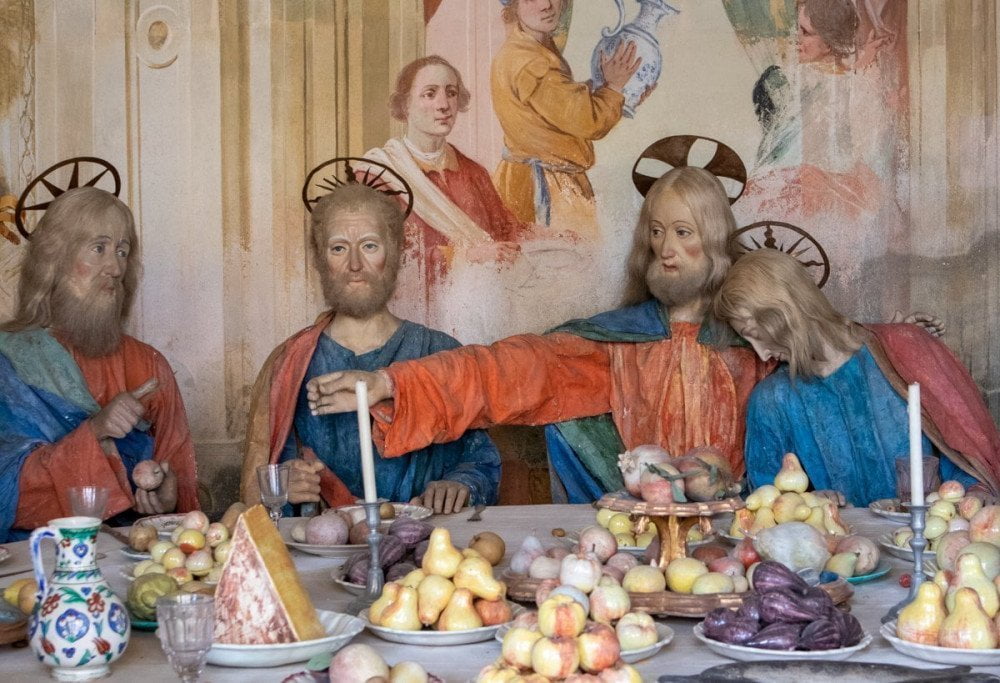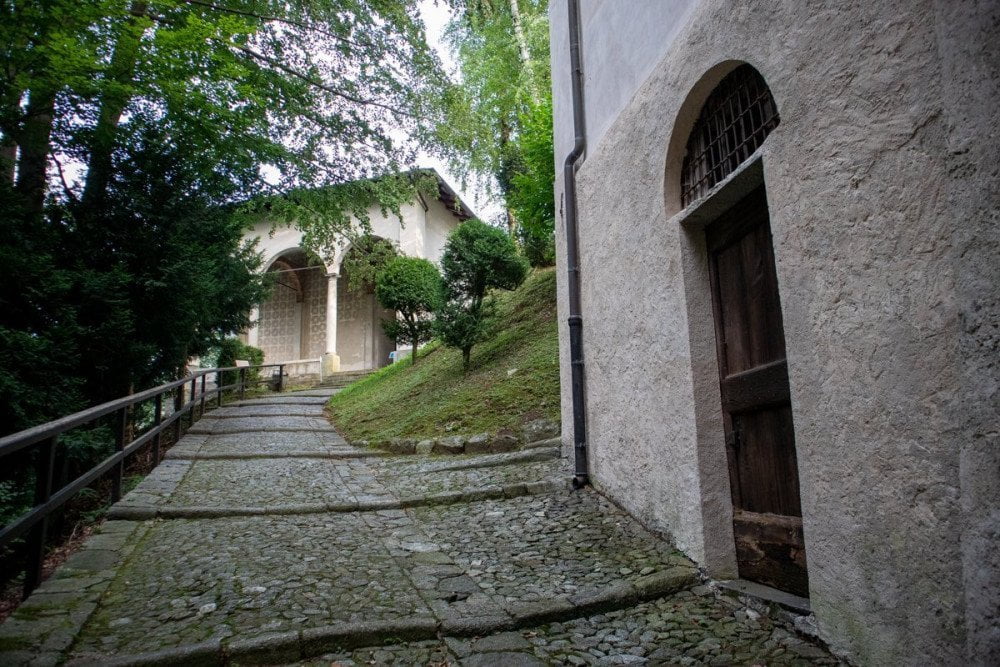The Sacro Monte of Varallo is the oldest and most important Sacred Mountain recognised as a UNESCO World Heritage Site, set on a rocky promontory in the Valsesia valley. The site features 45 chapels and a basilica, originally designed to recreate a “New Jerusalem” in northern Italy as an alternative pilgrimage destination to the Holy Land.
Table of Contents
Sacri Monti Explained: Italy’s Unique Religious Mountain Sites
The Sacro Monte of Varallo is part of the UNESCO World Heritage Site known as the Sacri Monti of Piedmont and Lombardy. The Italian term “Sacri Monti” refers to groups of religious buildings arranged around a specific theme and beautifully integrated into the natural landscape. This unique concept first emerged in the late 15th century as an alternative pilgrimage destination to Jerusalem and Palestine, which were then under Turkish control.
PLAN YOUR TRIP TO ITALY
Stay connected on the go with a Holafly eSIM, offering unlimited data at reliable 3G, 4G, and LTE speeds across Italy.
For added peace of mind during your travels, take out Heymondo travel insurance, perfect for a stress-free and well-protected adventure.
If you plan to explore beyond the main cities, renting a car is the best way to discover Italy’s hidden gems at your own pace.
The idea was conceived by the Franciscan friar Bernardino da Feltre, also known as Bernardino Caimi. After serving as the custodian of the Holy Sepulchre, he decided to recreate a topographical representation of Jerusalem in Valsesia. The original plan was to build three “New Jerusalems” in Varallo Sesia, Tuscany, and Portugal, but many more soon followed.
After the Council of Trent in the 16th century, the Sacri Monti format was widely adopted to promote Catholicism and counter the spread of Protestantism.
Essentially, the Sacri Monti became religious themed parks devoted to the life of Jesus, the Virgin Mary, the Trinity, the Saints, and the Rosary. Their rich decoration and style stood in stark contrast to Protestant churches, which favoured simplicity and a lack of ornamentation.
How Charles Borromeo Shaped the Sacri Monti
The growing popularity of the Sacri Monti soon attracted the attention of the Archbishop of Milan, Charles Borromeo, who imposed his vision on the Sacro Monte of Varallo, establishing it as a model for other sites. This bishop is commemorated by the colossal statue Sancarlone in Arona, erected following his canonisation.
However, it’s important to note that his legacy wasn’t entirely positive. In Switzerland, for instance, he authorised the arrest and torture of over 150 individuals accused of witchcraft, resulting in the execution of twelve women and a Protestant priest who refused to renounce their faith.
Due to Charles Borromeo’s influence, by the late 18th century, the Duchy of Milan had effectively monopolised the construction of Sacri Monti. New religious complexes were built in Crea, Ghiffa, Domodossola, Oropa, Orta, Ossuccio, Valperga, and Varese (listed alphabetically).
Each Sacro Monte was designed according to the same basic principles, functioning as a religious theme park. However, after the death of Charles Borromeo, each sanctuary continued to develop its own unique artistic and architectural style.

What to See at the Sacro Monte of Varallo
The Sanctuary of Sacro Monte di Varallo is home to 45 chapels, each adorned with frescoes and life-sized statues, and a basilica at the end of the path, just behind the “Golden Gate of Jerusalem”. The chapels and the basilica are connected by a network of streets and squares through the wooded hillside.
Architecturally, Sacro Monte is captivating because it’s basically a religious theme park. However, guided tours often focus more on spiritual significance rather than historical and artistic value. For this reason, they can be pretty boring if you’re more interested in art and history than faith.
Pilgrimage Route and Chapel Journey
The order of the chapels at Sacro Monte has evolved over time and no longer adheres to Bernardino Caimi’s original design. In the 15th century, the arrangement of the chapels was influenced by the topography of pilgrimage sites in the Holy Land.
However, during the Counter-Reformation, the purpose of Sacro Monte shifted. From merely replicating the Holy Land, it became a devotional journey through significant Catholic sacred sites. As a result, in the late 16th century, architect Galeazzo Alessi redesigned the route chronologically to reflect Jesus’s earthly path.

Statues and Frescoes in the Chapels
Each chapel at the Sacro Monte of Varallo features life-sized statues and frescoes. Some of them are creations of some of the finest Renaissance artists and sculptors. While some statues are awe-inspiring, others resemble ugly mannequins. I saw heads and hands attached to wooden frames, hidden beneath clothing to keep them upright. They are really scary.
However, these artworks are often difficult to see clearly. Charles Borromeo placed the statues behind wooden and glass barriers to physically separate the penitent pilgrims and the sacred scenes. Since these barriers weren’t intended to protect the artwork, one could argue that Charles Borromeo was just a snob.
The level of decoration varies from chapel to chapel. For example, the Chapel of the Last Supper is incredible kitsch despite being praised for its frescoes and statues. The figures of Jesus and the disciples are original late 15th-century mannequins with a rather unsettling appearance. Additionally, the rococo decorations and later additions, such as tablecloths, food items, and ornaments, make the chapel feel more like an eclectic antique shop than a place of worship.

Fun Fact About the Italian “New Jerusalem”
Over the centuries, many notable figures have contributed to the fame of the Sacro Monte of Varallo. The interest of clergy, nobles, and royalty helped make the Sanctuary renowned among their contemporaries.
This project’s primary visionary and promoter was the Franciscan friar Bernardino Caimi, followed by the painter and sculptor Gaudenzio Ferrari, who dedicated much of his career to the Sacro Monte.
From the mid-16th century, a key figure in promoting the Sacro Monte was Charles Borromeo, who utilised it to advance the principles of the Counter-Reformation. The construction and expansion of the sanctuary to its current form were financed by the royal House of Savoy.
After his visit in 1583, Charles Emmanuel I commissioned the Chapel of the Massacre of the Innocents, while the Marchioness of Messerano funded the Chapel of the Crucifixion.
Additionally, Matilda of Savoy sponsored the completion of another chapel and built a summer residence within the Sacro Monte itself.
In the 20th century, art critic, writer, and playwright Giovanni Testori coined the expression “great mountain theatre” to describe the dramatic effect created by the chapels of the Sacro Monte of Varallo.

How to Visit the Sacro Monte of Varallo
Despite its name, the “New Jerusalem” has little in common with the holy sites in Palestine. Having visited Jerusalem myself, I found no real similarities. The Sacro Monte feels more like a religious theme park.
The chapels are situated on a rocky promontory and connected by uphill paths. The walk through the Sacro Monte is intended as a spiritual journey, symbolising the effort required to reach the sanctuary at the summit.
When planning your visit, you should, therefore, consider opening times and accessibility because the Sacro Monte is located on a hill surrounded by nature.
Understanding the Accessibility of Sacro Monte
The Sacro Monte was originally designed as an open pilgrimage site for everyone. Still, today, it isn’t entirely accessible by modern standards. If you are visiting with a stroller or have mobility issues, you should know that the chapels are connected by unpaved paths. Also, there are several steps to navigate.
Although official information mentions some accessible routes, I recommend contacting the Tourist Office in advance for more detailed information. Only talking with a real person, you can know if these paths are truly manageable for your needs.
Opening Hours
The Basilica is open from 9:00 am to 5:30 pm. The Sacro Monte area, instead, is always open since there are no gates or walls surrounding the hill.
However, I recommend visiting during daylight hours. The path connecting the chapels, in fact, winds through a wood without public lighting.
How to Get to the Sacro Monte of Varallo
Reaching the Sacro Monte by public transport is quite complicated. In fact, there are no direct buses or trains from Turin or Milan to Varallo. The Varallo Sesia railway has been discontinued and is only occasionally serviced by historic trains. To reach Varallo by train, take a train to Vercelli and then catch bus 50 to Varallo.
If you’re interested in visiting the Valsesia area or just the Sacro Monte of Varallo, I highly recommend renting a car. To reach Varallo Sesia by car, the nearest motorway exit is Romagnano Sesia. From there, follow Provincial Road 299 to Varallo. There is a car park in town about two kilometres from the Sanctuary. You can use Google Maps to ensure you find the correct route.
The Sacro Monte is located within a Protected Area in the Piedmont Region. Despite this, you can reach the Sanctuary directly by car from Varallo at the time of writing.
However, the most scenic routes to the Sacro Monte from Varallo are walking or taking the cable car. The cable cars depart from behind the Santa Maria delle Grazie church, which is famous for the Gaudenzio Wall, a series of frescoes depicting the life of Jesus.
Santuario del Sacro Monte di Varallo
Piazza G. Testori, 13019 Varallo (VC)
Feel free to share your thoughts in the comments about the Sacro Monte of Varallo. Do you think it’s an interesting destination due to its historical significance? Or do you think it still serves an evangelising purpose, centuries after its construction? Perhaps you see it as just a curious place to visit. Let me know!
